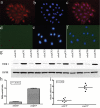TREM-1 expression in craniopharyngioma and Rathke's cleft cyst: its possible implication for controversial pathology
- PMID: 27409178
- PMCID: PMC5226603
- DOI: 10.18632/oncotarget.10501
TREM-1 expression in craniopharyngioma and Rathke's cleft cyst: its possible implication for controversial pathology
Abstract
Whether a mixed type of craniopharyngioma (CP) exists and whether papillary craniopharyngioma (pCP) is on a histopathological continuum with Rathke's cleft cyst (RCC) remain controversial. Herein, we examined the expression and localization of β-catenin, BRAF p.V600E (V600E), and triggering receptor expressed on myeloid cells-1 (TREM-1) in 58 samples including 20 pCPs, 26 adamantinomatous craniopharyngiomas (aCP), and 12 RCCs. Five aCPs were diagnosed with mixed type CPs and the remaining 21 cases were pure aCPs. Four of the 12 RCCs presented with significant squamous epithelium (SE). V600E immunoreactivity was observed in all pCPs in the cytoplasm, but not in the nuclei. aCPs and RCCs, including mixed type CP, did not express V600E. Nuclear β-catenin translocation was detected exclusively in aCPs. TREM-1 was expressed in pCPs. Additionally, TREM-1 expression was detected in the SE of 5 "mixed type" CPs, while it was absent in pure aCPs. TREM-1 was expressed in 4 RCCs with SE, but not in the remaining 8 RCCs. TREM-1 mRNA levels were compared in cultured pCP and aCP cells. TREM-1 mRNA level was significantly (p < 0.001; up to 4.045 fold) higher in pCPs than in aCPs. Western blotting revealed a significantly (p < 0.001; up to 7.19 fold) lower level of TREM-1 expression in aCP cells compared to that in pCP cells. Our findings further supported that RCC and pCP may represent two ends of a morphological spectrum. A variant showing overlapping histological features of aCP and pCP should not be considered as a mixed type.
Keywords: Rathke’s cleft cyst; SE; TREM-1; craniopharyngioma; metaplasia.
Conflict of interest statement
The authors declare that they have no conflicts of interest.
Figures





Similar articles
-
The role of BRAF testing of Rathke's cleft cysts to identify missed papillary craniopharyngioma.Pituitary. 2025 Feb 3;28(1):30. doi: 10.1007/s11102-025-01501-8. Pituitary. 2025. PMID: 39900703 Free PMC article.
-
Study of β-catenin and BRAF alterations in adamantinomatous and papillary craniopharyngiomas: mutation analysis with immunohistochemical correlation in 54 cases.J Neurooncol. 2017 Jul;133(3):487-495. doi: 10.1007/s11060-017-2465-1. Epub 2017 May 12. J Neurooncol. 2017. PMID: 28500561
-
[Implication of BRAF V600E and CTNNB1 gene mutations in the pathological classification of craniopharyngioma].Zhonghua Bing Li Xue Za Zhi. 2019 Sep 8;48(9):682-687. doi: 10.3760/cma.j.issn.0529-5807.2019.09.004. Zhonghua Bing Li Xue Za Zhi. 2019. PMID: 31495087 Chinese.
-
Pathology and pathogenesis of craniopharyngiomas.Pituitary. 2013 Mar;16(1):9-17. doi: 10.1007/s11102-012-0418-4. Pituitary. 2013. PMID: 22886701 Review.
-
Craniopharyngioma-An update on metabolic and cognitive complications and new therapy.J Intern Med. 2023 Sep;294(3):269-280. doi: 10.1111/joim.13684. Epub 2023 Jul 9. J Intern Med. 2023. PMID: 37424210 Review.
Cited by
-
Prediction of calcification tendency in pediatric cystic adamantinomatous craniopharyngioma by using inflammatory markers, hormone markers, and radiological appearances.Childs Nerv Syst. 2019 Jul;35(7):1173-1180. doi: 10.1007/s00381-019-04178-0. Epub 2019 May 7. Childs Nerv Syst. 2019. PMID: 31062140
-
Rathke cleft cyst with squamous metaplasia and activating mutations of mitogen-activated protein kinase signaling: illustrative case.J Neurosurg Case Lessons. 2025 Jan 20;9(3):CASE24657. doi: 10.3171/CASE24657. Print 2025 Jan 20. J Neurosurg Case Lessons. 2025. PMID: 39832308 Free PMC article.
-
Soluble triggering receptor expressed on myeloid cell-1 (sTREM-1): a potential biomarker for the diagnosis of infectious diseases.Front Med. 2017 Jun;11(2):169-177. doi: 10.1007/s11684-017-0505-z. Epub 2017 Apr 19. Front Med. 2017. PMID: 28425045 Review.
-
Can tissue biomarkers reliably predict the biological behavior of craniopharyngiomas? A comprehensive overview.Pituitary. 2018 Aug;21(4):431-442. doi: 10.1007/s11102-018-0890-6. Pituitary. 2018. PMID: 29700680 Review.
-
The diagnostic value of preoperative inflammatory markers in craniopharyngioma: a multicenter cohort study.J Neurooncol. 2018 May;138(1):113-122. doi: 10.1007/s11060-018-2776-x. Epub 2018 Jan 31. J Neurooncol. 2018. PMID: 29388032
References
-
- Larkin SJ, Ansorge O. Pathology and pathogenesis of craniopharyngiomas. Pituitary. 2013;16:9–17. - PubMed
-
- Martinez-Barbera JP, Buslei R. Adamantinomatous craniopharyngioma: pathology, molecular genetics and mouse models. J Pediatr Endocrinol Metab. 2015;28:7–17. - PubMed
-
- Prabhu VC, Brown HG. The pathogenesis of craniopharyngiomas. Childs Nerv Syst. 2005;21:622–627. - PubMed
-
- Zada G, Lin N, Ojerholm E, Ramkissoon S, Laws ER. Craniopharyngioma and other cystic epithelial lesions of the sellar region: a review of clinical, imaging, and histopathological relationships. Neurosurg Focus. 2010;28:E4. - PubMed
-
- Okada T, Fujitsu K, Ichikawa T, Mukaihara S, Miyahara K, Kaku S, Uryuu Y, Niino H, Yagishita S, Shiina T. Coexistence of adamantinomatous and squamous-papillary type craniopharyngioma: case report and discussion of etiology and pathology. Neuropathology. 2012;32:171–173. - PubMed
MeSH terms
Substances
LinkOut - more resources
Full Text Sources
Other Literature Sources
Research Materials
Miscellaneous

